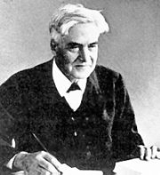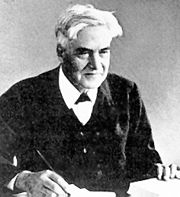
Robert T. A. Innes
Encyclopedia

Robert Thorburn Ayton Innes (November 10, 1861 – March 13, 1933) was a Scottish
Scotland
Scotland is a country that is part of the United Kingdom. Occupying the northern third of the island of Great Britain, it shares a border with England to the south and is bounded by the North Sea to the east, the Atlantic Ocean to the north and west, and the North Channel and Irish Sea to the...
-South Africa
South Africa
The Republic of South Africa is a country in southern Africa. Located at the southern tip of Africa, it is divided into nine provinces, with of coastline on the Atlantic and Indian oceans...
n astronomer
Astronomer
An astronomer is a scientist who studies celestial bodies such as planets, stars and galaxies.Historically, astronomy was more concerned with the classification and description of phenomena in the sky, while astrophysics attempted to explain these phenomena and the differences between them using...
best known for discovering Proxima Centauri
Proxima Centauri
Proxima Centauri is a red dwarf star about 4.2 light-years distant in the constellation of Centaurus. It was discovered in 1915 by Robert Innes, the Director of the Union Observatory in South Africa, and is the nearest known star to the Sun, although it is too faint to be seen with the naked eye...
in 1915, and numerous binary star
Binary star
A binary star is a star system consisting of two stars orbiting around their common center of mass. The brighter star is called the primary and the other is its companion star, comes, or secondary...
s. He was also the first astronomer to have seen the Great January Comet of 1910, on January 12. He was the founding director of a meteorological
Meteorology
Meteorology is the interdisciplinary scientific study of the atmosphere. Studies in the field stretch back millennia, though significant progress in meteorology did not occur until the 18th century. The 19th century saw breakthroughs occur after observing networks developed across several countries...
station in Johannesburg, which he converted to an astronomical observatory
Observatory
An observatory is a location used for observing terrestrial or celestial events. Astronomy, climatology/meteorology, geology, oceanography and volcanology are examples of disciplines for which observatories have been constructed...
and renamed to Union Observatory
Union Observatory
Union Observatory was an astronomical observatory located in the suburb Observatory, Johannesburg, South Africa. It bears IAU code 078.Known as the Transvaal Observatory in its early years, it became the Republic Observatory in 1961...
. He was the first Union Astronomer. Innes House, designed by Herbert Baker
Herbert Baker
Sir Herbert Baker was a British architect.Baker was the dominant force in South African architecture for two decades, 1892–1912....
, built as his residence at the observatory, today houses the South African Institute of Electrical Engineers
South African Institute of Electrical Engineers
The South African Institute of Electrical Engineers is a professional association representing electrical and electronic engineers, technologists and technicians in Southern Africa. The organisation is listed as a recognised Voluntary Association by the Engineering Council of South Africa , the...
.
Biography
He was born on November 10, 1861 in EdinburghEdinburgh
Edinburgh is the capital city of Scotland, the second largest city in Scotland, and the eighth most populous in the United Kingdom. The City of Edinburgh Council governs one of Scotland's 32 local government council areas. The council area includes urban Edinburgh and a rural area...
.
A self-taught astronomer, he went to Australia
Australia
Australia , officially the Commonwealth of Australia, is a country in the Southern Hemisphere comprising the mainland of the Australian continent, the island of Tasmania, and numerous smaller islands in the Indian and Pacific Oceans. It is the world's sixth-largest country by total area...
at an early age and made his living as a wine merchant in Sydney
Sydney
Sydney is the most populous city in Australia and the state capital of New South Wales. Sydney is located on Australia's south-east coast of the Tasman Sea. As of June 2010, the greater metropolitan area had an approximate population of 4.6 million people...
, where, using a home made 12-inch reflecting telescope
Reflecting telescope
A reflecting telescope is an optical telescope which uses a single or combination of curved mirrors that reflect light and form an image. The reflecting telescope was invented in the 17th century as an alternative to the refracting telescope which, at that time, was a design that suffered from...
, he discovered several double stars new to astronomy. He also published some papers on perturbations
Perturbation (astronomy)
Perturbation is a term used in astronomy in connection with descriptions of the complex motion of a massive body which is subject to appreciable gravitational effects from more than one other massive body....
in Mars
Mars
Mars is the fourth planet from the Sun in the Solar System. The planet is named after the Roman god of war, Mars. It is often described as the "Red Planet", as the iron oxide prevalent on its surface gives it a reddish appearance...
' and Venus
Venus
Venus is the second planet from the Sun, orbiting it every 224.7 Earth days. The planet is named after Venus, the Roman goddess of love and beauty. After the Moon, it is the brightest natural object in the night sky, reaching an apparent magnitude of −4.6, bright enough to cast shadows...
' orbits.
Despite having had no formal training in astronomy, he was invited to the Cape Observatory by the astronomer royal Sir David Gill
David Gill (astronomer)
Sir David Gill FRS was a Scottish astronomer who is known for measuring astronomical distances, for astrophotography, and for geodesy. He spent much of his career in South Africa.- Life and work :...
in 1894 and appointed in 1896. In 1903 he took up the position of Director of the new Meteorological Observatory in Johannesburg
Johannesburg
Johannesburg also known as Jozi, Jo'burg or Egoli, is the largest city in South Africa, by population. Johannesburg is the provincial capital of Gauteng, the wealthiest province in South Africa, having the largest economy of any metropolitan region in Sub-Saharan Africa...
. He acquired the observatory's first telescope, a 9-inch refractor, in 1906, and was appointed first Union Astronomer in 1912. A 26-inch refractor and the Franklin Adams camera were added.
The University of Leyden awarded him a honoris causa doctorate in 1923. He retired in 1927. He died on March 13, 1933.
Legacy
Innes tirelessly campaigned for foreign investment in South Africa's astronomy infrastructure - he believed that its clear skies were ideally suited for astronomical observation. He discovered some 1600 new pairs of double stars, had a great interest in stellar proper motionProper motion
The proper motion of a star is its angular change in position over time as seen from the center of mass of the solar system. It is measured in seconds of arc per year, arcsec/yr, where 3600 arcseconds equal one degree. This contrasts with radial velocity, which is the time rate of change in...
s and devoted much time to the study of Jupiter
Jupiter
Jupiter is the fifth planet from the Sun and the largest planet within the Solar System. It is a gas giant with mass one-thousandth that of the Sun but is two and a half times the mass of all the other planets in our Solar System combined. Jupiter is classified as a gas giant along with Saturn,...
's satellites.
He discovered Innes star.
Honors
The following features have been named after him:- The lunar crater InnesInnes (crater)Innes is a lunar impact crater on the Moon's far side. It is located less than a crater diameter to the east-southeast of the prominent crater Seyfert. To the southeast of Innes is the crater Meggers, and to the west-southwest lies Polzunov....
. - The asteroidAsteroidAsteroids are a class of small Solar System bodies in orbit around the Sun. They have also been called planetoids, especially the larger ones...
1658 Innes1658 Innes1658 Innes is a main-belt asteroid discovered from Johannesburg on 13 July 1953 by J. A. Bruwer and named after the Scottish-South African astronomer Robert T. A. Innes.- External links :**...
.

